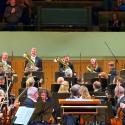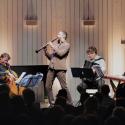Sir Mark Elder’s zest for exploring fresh territory with the forces of the Hallé is unquenched even in his final season as music director. And who better to introduce the Stabat Mater of Rossini – a late flowering of the operatic wizard’s powers – than he, a champion of the rich and rare from operas past?
It is, whatever else may be said, highly operatic in many aspects – and not unique in that respect in 19th century sacred music. Like other examples, it was premiered (in its final version) in a theatre, not a cathedral.
For this performance there were both a starry quartet of soloists and the many-throated resources of the Hallé Choir, so quality of tone in the solo voices and a capacity for thunderous climaxes were both available, and Elder is never one to ignore such possibilities. The downside of the piece, in the view of some, is the near-doggerel nature of parts of the Latin text, but there is the compensation that its short, plodding lines in couplet pattern have often given composers freedom to create their own structures using the text as little more than a prop.
 So it was with Rossini. But Sir Mark still wanted the words to be an essential part of the work’s impact and asked his choir and soloists to spit their consonants out at key moments, as well as ensuring the timpani of the orchestra packed a punch in the orchestral sound when required.
So it was with Rossini. But Sir Mark still wanted the words to be an essential part of the work’s impact and asked his choir and soloists to spit their consonants out at key moments, as well as ensuring the timpani of the orchestra packed a punch in the orchestral sound when required.
There are two unaccompanied numbers in the piece: “Eja, Mater” for bass soloist and chorus, and “Quando corpus morietur” for the solo quartet, where his ability to control and inspire voices was heard to the maximum: indeed in the former case a massive crescendo from the choir was momentarily near to coarseness, but at its close they gave him a near-Elgarian swell and fade on the final chord which appealed a lot.
The soloists shone in their appointed moments of glory (pictured above) in particular. Rangwanasha, whose beautiful soprano has graced the Bridgewater Hall before now, soared clear and true in the “Quis est homo” duet alongside Claudia Huckle’s warm and insistent mezzo – and with a pretty impressive duet-cadenza to finish – and the former outstanding also in the full-throttle aria and chorus of “Inflammatus”, while the latter brought passion and distinction to “Fac ut portem”.
Enea Scala and William Thomas completed the vanguard, Scala bringing his thrilling Italian style to the entertaining aria, “Cujus animam gementem”, with its jolly rum-ti-tum orchestral accompaniment – and a very big final top note – and Thomas giving a quality of nobility and sustaining power to his “Pro peccatis”.
In the final chorus there was a rollicking tempo for the fugue, making the most of the contrast that comes as it’s punctuated by a re-introduction of the opening orchestral themes, and then some exciting extended fortissimo choral singing to the finishing line. Choral director Matthew Hamilton had prepared his forces very well.
The first part of the concert was Beethoven’s Symphony No. 2. I love the way Elder does Beethoven, especially the symphonies that others might regard as less revolutionary and romantic than the odd-numbered ones. He uses a well populated orchestra, with a slight preponderance towards the middle and lower sections in the strings (led by Roberto Ruisi and playing senza vibrato throughout) and the old-fashioned, at times completely penetrating, thud of traditional timpani (Erika Öhman), but they skip along with alacrity. The variety of tone and versatility you will hear from the Hallé strings today is remarkable.
Every pause or pianissimo is moment of high drama in an Elder interpretation of Beethoven. The Larghetto second movement was both a rhythmic jog and a sequence of rise-and-fall phrasing, and the horns were suavity itself. The Scherzo was fleet of foot and at times explosive, and the finale full of the silences and outbursts that continue to surprise us even now.
- More classical reviews on theartsdesk
- Recorded for broadcast on Radio 3 on 5 December















Add comment